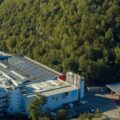Rio Tinto is building a sustainable and renewable energy project in the Canadian territories. This project will consist of the construction of the largest solar plant ever installed in the country and will have more than 6,600 solar panels to create carbon-free electricity, with production set at approximately 4,200 megawatt-hours per year for the Diavik diamond mine.
Specifically, the solar power plant will also provide up to 25% of Diavik’s electricity during decommissioning work that will extend through 2029, with commercial production from the operation expected to be completed in early 2026.
This installation will have bifacial solar panels on Diavik that will take advantage not only of direct sunlight, but also of the reflection of the sun’s rays on the snow. This will also reduce diesel consumption in the area by approximately one million liters per year while reducing emissions by 2,900 tons of CO2 equivalent, which is comparable to eliminating emissions from 630 cars.
Diavik Diamond Mine President and COO Angela Bigg added, “I am delighted that we will significantly increase our renewable energy generation with the largest solar power plant in Canada’s Northern Territories at the Diavik Diamond Mine. Through its wind-diesel hybrid power facility, Diavik is already a leader in cold weather renewable technology and this important project reinforces our dedication to reducing our carbon footprint. I would like to thank both the Government of the Northwest Territories and the Government of Canada for their support in deploying this project.”
The solar power plant will significantly expand Diavik’s renewable energy generation, which already has a wind-diesel hybrid power facility that has a capacity of 55.4 MW and provides the site’s electricity.
This initiative is being financed with approximately 3.9 million Canadian dollars. Specifically, the Government of the Northwest Territories will provide $3.3 million in grants to reduce greenhouse gas emissions while the additional amount will come through the Federal Government’s Clean Electricity Investment Tax Credit.
Caroline Wawzonek, Minister of Finance for the Northwest Territories, praised Rio Tinto for its decision to build the Diavik solar plant. “The Diavik solar power plant is a welcome sign of Rio Tinto’s commitment to renewable energy and emissions reductions. The Northwest Territories Government is pleased to have provided support through the GHG investment reduction grant program for large emitters, one of the original pieces of our made-in-NWT approach to the federal carbon tax. This collaboration exemplifies our commitment to facilitating sustainable development while reducing GHG emissions in the Northwest Territories and should be a sign of how our economic development can continue to position us as leaders in these areas,” the Minister reiterated.
Rio Tinto is also committed to achieving a carbon-free future. In its global operations, it has set a target to reduce its Scope 1 and 2 greenhouse gas (GHG) emissions by 50% by 2030 and to achieve net zero emissions in all its operations by 2050. The construction process for the solar power plant will begin shortly and is expected to be operational in early 2024.
Canada’s Northwest Territories has created an Investment Grant Program to reduce greenhouse gases. The GNWT also stated that twelve percent (12%) of the carbon taxes paid by prescribed large emitters would be available for projects that help reduce emissions. The Diavik solar power plant is the first project to be funded under the Greenhouse Gas Investment Reduction Grant Program for large emitters.














